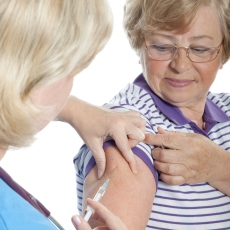
Shingles
Also called: Herpes zoster, Postherpetic neuralgia
National Institutes of Health
Other Languages
What is shingles?
Shingles is an outbreak of rash or blisters on the skin. It is caused by the varicella-zoster virus - the same virus that causes chickenpox. After you have chickenpox, the virus stays in your body. It may not cause problems for many years. But as you get older, the virus may reappear as shingles.
Is shingles contagious?
Shingles is not contagious. But you can catch chickenpox from someone with shingles. If you've never had chickenpox or the chickenpox vaccine, try to stay away from anyone who has shingles.
If you have shingles, try to stay away from anyone who has not had chickenpox or the chickenpox vaccine, or anyone who might have a weak immune system.
Who is at risk for shingles?
Anyone who has had chickenpox is at risk for getting shingles. But this risk goes up as you get older; shingles is most common in people over age 50.
People with weakened immune systems are at higher risk of getting shingles. This includes those who
- Have immune system diseases such as HIV/AIDS
- Have certain cancers
- Take immunosuppressive drugs after an organ transplant
Your immune system may be weaker when you have an infection or are stressed. This can raise your risk of shingles.
It is rare, but possible, to get shingles more than once.
What are the symptoms of shingles?
Early signs of shingles include burning or shooting pain and tingling or itching. It is usually on one side of the body or face. The pain can be mild to severe.
One to 14 days later, you will get a rash. It consists of blisters that typically scab over in 7 to 10 days. The rash is usually a single stripe around either the left or the right side of the body. In other cases, the rash occurs on one side of the face. In rare cases (usually among people with weakened immune systems), the rash may be more widespread and look similar to a chickenpox rash.
Some people may also have other symptoms:
- Fever
- Headache
- Chills
- Upset stomach
What are the complications of shingles?
Shingles can cause complications:
- Postherpetic neuralgia (PHN) is most common complication of shingles. It causes severe pain in the areas where you had the shingles rash. It usually gets better in a few weeks or months. But some people can have pain from PHN for many years, and it can interfere with daily life.
- Vision loss can happen if shingles affects your eye. It may be temporary or permanent.
- Hearing or balance problems are possible if you have shingles within or near your ear. You may also have weakness of the muscles on that side of your face. These problems can be temporary or permanent.
Very rarely, shingles can also lead to pneumonia, brain inflammation (encephalitis), or death.
How is shingles diagnosed?
Usually your health care provider can diagnose shingles by taking your medical history and looking at your rash. In some cases, your provider may scrap off tissue from the rash or swab some fluid from the blisters and send the sample to a lab for testing.
What are the treatments for shingles?
There is no cure for shingles. Antiviral medicines may help to make the attack shorter and less severe. They may also help prevent PHN. The medicines are most effective if you can take them within 3 days after the rash appears. So if you think you might have shingles, contact your health care provider as soon as possible.
Pain relievers may also help with the pain. A cool washcloth, calamine lotion, and oatmeal baths may help relieve some of the itching.
Can shingles be prevented?
There are vaccines to prevent shingles or lessen its effects. The Centers for Disease Control and Prevention recommends that healthy adults 50 years and older get the Shingrix vaccine. You need two doses of the vaccine, given 2 to 6 months apart. Another vaccine, Zostavax, may be used in certain cases.
- Chickenpox and Shingles Tests (American Association for Clinical Chemistry)
- Shingles Transmission (Centers for Disease Control and Prevention)Also in Spanish
- Sting of Shingles: Vaccine, Treatments Reduce Risks
 (National Institutes of Health)Also in Spanish
(National Institutes of Health)Also in Spanish - What Everyone Should Know about Shingles Vaccine (Shingrix)(Centers for Disease Control and Prevention)
- What Everyone Should Know about Zostavax (Centers for Disease Control and Prevention)
- Herpes Zoster Oticus
 (National Institute of Neurological Disorders and Stroke)
(National Institute of Neurological Disorders and Stroke) - Postherpetic Neuralgia (Mayo Foundation for Medical Education and Research)Also in Spanish
- Ramsay Hunt Syndrome (Mayo Foundation for Medical Education and Research)
- Genetics Home Reference: shingles
 (National Library of Medicine)
(National Library of Medicine)
- Photos of Shingles (Centers for Disease Control and Prevention)
- Shingles (Herpes Zoster) (American Academy of Dermatology)
- Shingles (Zoster) (Logical Images)
- ClinicalTrials.gov: Herpes Zoster
 (National Institutes of Health)
(National Institutes of Health) - ClinicalTrials.gov: Neuralgia, Postherpetic
 (National Institutes of Health)
(National Institutes of Health)
- Find a Dermatologist (American Academy of Dermatology)
- National Institute of Allergy and Infectious Diseases

- National Institute of Neurological Disorders and Stroke
 Also in Spanish
Also in Spanish
- Shingles (For Parents) (Nemours Foundation)Also in Spanish
- Prevent Shingles (Centers for Disease Control and Prevention)Also in Spanish
- Shingles
 (National Institute on Aging)Also in Spanish
(National Institute on Aging)Also in Spanish
- Post-herpetic neuralgia - aftercare (Medical Encyclopedia)Also in Spanish
- Ramsay Hunt syndrome (Medical Encyclopedia)Also in Spanish
- Shingles (Medical Encyclopedia)Also in Spanish
- Shingles - aftercare (Medical Encyclopedia)Also in Spanish
- Shingles Vaccine: What You Need to Know (Centers for Disease Control and Prevention) - PDF






















.png)











No hay comentarios:
Publicar un comentario